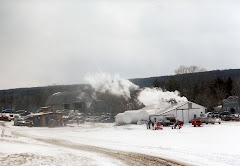Here's a press release I received about an upcoming exhibit
FRANK LLOYD WRIGHT'S BUFFALO VENTURE IS SUBJECT OF ANDERSON GALLERY EXHIBITION
Multimedia is available with this article online athttp://www.buffalo.edu/news/10395
Release date: Friday, August 28, 2009
Contact: Patricia Donovan,
pdonovan@buffalo.edu
Phone: 716-645-4602
Fax: 716-645-3765
BUFFALO, N.Y. -- "Frank Lloyd Wright's Buffalo Venture: From the Larkin Building to Broadacre City," is an exhibition focused on the context in which Buffalo became a locus for Wright's architectural activities in the first decades of the 20th century.
It will be presented by the University at Buffalo Anderson Gallery Oct.2 to Dec. 30. The exhibition will be free of charge and open to the public in the Anderson, One Martha Jackson Place (off Englewood Avenue between Main Street and Kenmore Avenue).Gallery hours are Wednesday through Saturday 11 a.m. to 5 p.m. and Sunday 1-5 p.m. For information, call 716-829-3754.
The exhibition will present more than 130 objects, including those related to 22 buildings and projects -- 11 built works and 11unrealized projects -- that resulted from Wright's 32-year association with the forward-thinking executives of the Larkin Company, a once-prominent soap and mail order business based in Buffalo.
The exhibition will be open during the 2009 national conference of the Frank Lloyd Wright Building Conservancy, "Wright in the Drafting Room: Drawings for the Built and Unbuilt," which will take place in Buffalo Oct. 7-11. On Oct. 8, the Anderson Gallery will host a reception for conference attendees.
UB Gallery Director Sandra Olsen says, "The theme of the exhibition --Buffalo as the site of a remarkable patronage -- will be explicated through a diverse set of materials, including building models, plans,photographic documentation and, perhaps most important, numerous letters and other correspondence between Wright and his Buffalo clients."
Jack Quinan, Ph.D., curator of the exhibition, is one of the most important scholars working today on Wright and his work. An art historian and SUNY Distinguished Service Professor in the UB Department of Visual Studies, he is the author of several books on the Wright-Buffalo connection, including "Frank Lloyd Wright's Martin House: Architecture as Portraiture" (2004, Princeton Architectural Press).
Quinan says the exhibition will shed new light on Wright's many unrealized projects related to Larkin patrons, as well as on such well-known built projects as the Larkin Building, the Darwin D. Martin House and Graycliff, the Martin summer house in Derby, N.Y., outside Buffalo.
He says, "It will include original material and reproductions on loan from the Frank Lloyd Wright Foundation at Taliesin West, the Getty Research Institute, the UB Archives, and original furniture from the Albright-Knox Art Gallery and the New York State Bureau of Historic Sites."
Quinan will produce a 30-page brochure on the exhibit and later, a book on the subject. He will be aided in these endeavors by the exhibit's consulting curator Molly S. Hutton, Ph.D.
"The opening will provide a context for the nearly completed restorations of the Darwin Martin House," he says, "a $50-million effort that encompasses the full six-building Martin complex and the Eleanor and Wilson Greatbatch Pavilion, a minimalist visitor center designed by award-winning architect Toshiko Mori.
"It also will contextualize the restoration of Graycliff, for which Mrs. Martin was the lead client," says Quinan.
According to Olsen, this is the first time this material has been assembled and presented for scholarly re-evaluation and public education. She says the Anderson will offer a variety of educational programs in connection with the exhibit, among them a lecture series and tours conducted by the docents of Wright's Darwin Martin House.
"The title of the exhibition," says Quinan, "was chosen to demonstrate the length of Wright's involvement with his Buffalo clients and the tenacity with which those clients -- especially Darwin Martin --patronized and sustained him between the twin pinnacles of his career,the Prairie period (1900-1910) and the final decades (1937-1959) during which he designed Fallingwater, the Johnson's Wax Building, Taliesin West and the Guggenheim Museum.
"It refers specifically to two of Wright's innovative designs.
The first is the remarkable five-story, red brick Larkin Administration Building (1904-50) designed for the Larkin Soap Company and built on Seneca Street in Buffalo. Among its many innovations were air conditioning, built-in metal desk furniture, glass doors, radiant heat, a wide-open, multi-storied workspace, toilet bowls suspended from the bathroom walls and ornamentation by sculptor Richard Bock.
The second project mentioned is Broadacre City, a development concept proposed by Wright in his 1932 book, "The Disappearing City" and inspired by the rise of interstate highway travel and the Great Depression.
Commonly described as the "antithesis of the city and the apotheosis of the newly born suburbia," Broadacre was unveiled by Wright in 1935 in a very detailed 12-foot-by-12-foot scale model that represented a hypothetical four-square-mile community for 1,400 families.
The exact opposite of transit-oriented development, Broadacre incorporated many of the garden city ideas of urban planner Ebenezer Howard. Wright called it not just the destiny of a mature industrial society, but "the plastic form of a genuine democracy." He continued to plan and publish on this project until his death in 1959.
The exhibition is made possible through a grant from the New York Council on the Humanities, and support from the Interdisciplinary Research Development Fund of the Office of the UB Vice President for Research, the St. Simon Charitable Foundation, Inc., and the Martin House Restoration Corporation.
Any views, findings, conclusions or recommendations expressed in this news release or exhibition do not necessarily represent those of the National Endowment for the Humanities.
The University at Buffalo is a premier research-intensive public university, a flagship institution in the State University of New York system and its largest and most comprehensive campus. UB's more than 28,000 students pursue their academic interests through more than 300 undergraduate, graduate and professional degree programs. Founded in 1846, the University at Buffalo is a member of the Association of American Universities.
See this article online at: http://www.buffalo.edu/news/10395
Subscribe to:
Post Comments (Atom)











No comments:
Post a Comment